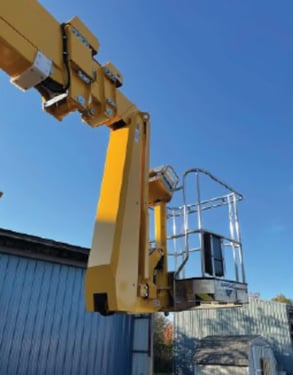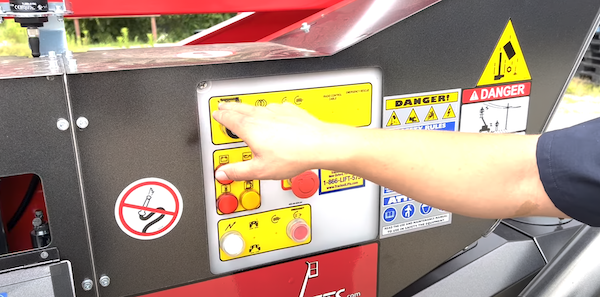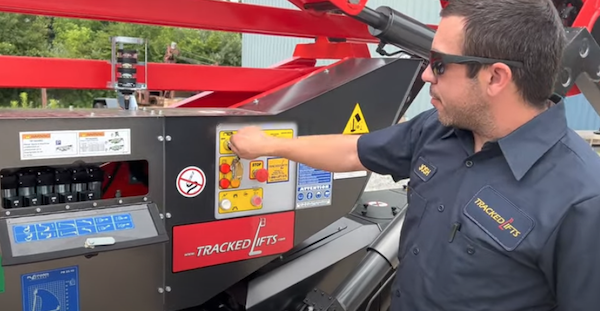Most Compact-Lift Failures Are Preventable
The experts – those who make and sell compact lifts and, ultimately, have to do a lot of the repairs – say the causes of the majority of compact-lift “fails,” as the slang goes, boil down to one of two things: operator error or lack of maintenance.
With respect to operator error, Mike Hrycak, president of Tracked Lifts, Inc., a 14-year TCIA corporate member company based in New Oxford, Pennsylvania, takes on the issue of tip-overs and says avoiding damage from this kind of failure is knowing how to prevent it in the first place. He states directly, “The number-one reason machines come into our shops is from driving on uneven terrain – and it’s 100% preventable.”
It begins before the job starts, “by pre-planning the route your equipment will take from the delivery vehicle to the drop site,” he observes. “Minimize the need to drive on side-slope terrain. If that cannot be avoided, make sure the tracks are set to the widest setting, if the machine is equipped with tracks that adjust.”
“The number-one reason machines come into our shops is from driving on uneven terrain – and it’s 100% preventable.” Mike Hrycak
One travel technique is often overlooked, he says. “Outriggers should be deployed to within a few inches of the ground. If traversing over uneven terrain and the land shifts, deployed outriggers will prevent tip-over.” However, Hrycak adds, “Should you not have enough room to deploy outriggers due to proximity to a building or fence, crib the machine on the down-slope track with plywood, synthetic mats, outrigger pads or even lumber, just to build up the terrain for the downhill track so the machine can drive reasonably level.” As a personnel safety point, he warns, “Avoid walking downhill of the machine, no matter what!”
Another pointer to help avoid a failure-inducing tip-over, according to Hrycak, is, “You should not drive next to a retaining wall that might give out under the weight of the machine.”
Hrycak reports that if one includes all damage-related events, “In most cases, soft parts of the machine compartments are affected, such as the engine, electrical-control panels, baskets and occasionally boom segments.” He stresses that “The single-most vulnerable component in a tip-over is the boom-rotation bearing, which absorbs the brunt of the impact because it is the joint between the chassis and the boom. That bearing absorbs major impact from a sideways tip-over.”
Two aspects are affected, he continues. “Cracks occur in the boom bearing, especially near the worm-gear housing on the bearing. Also, bolts that hold the boom to the bearing and chassis-to-bearing bolts might stretch. Close inspection of the bearing for cracks is mandatory following a tip-over.”
The first step to assess the damage is “torquing down all bolts of the bearing. This should be performed to verify none have stretched or broken. In many cases, clients will take an added preventive step of replacing the bearing and bolts if impact is severe enough,” he adds.
Speaking of prevention, Hrycak says, “We recommend a synthetic, waterproof, marine-type grease for winter lubrication and the use of dry lubricants on mechanical safety sensors. This prevents winter dirt from gunking up sensitive components.”
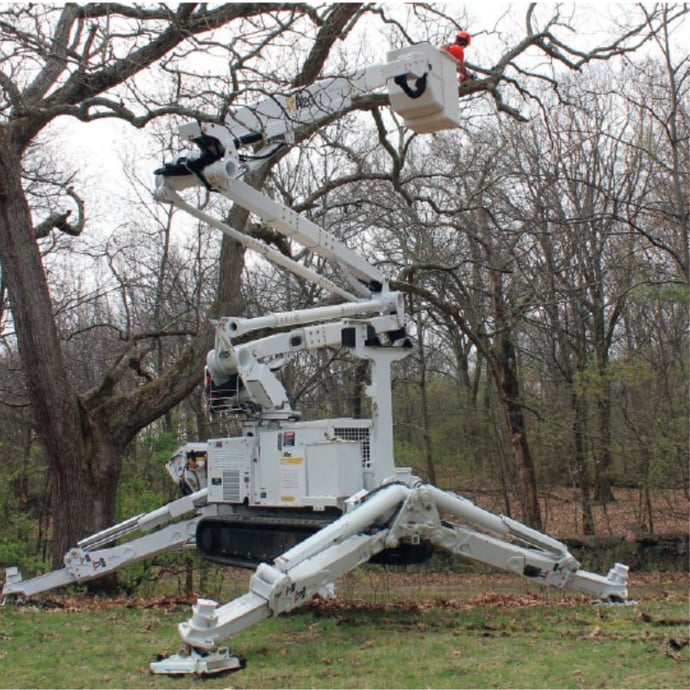
Another ounce of prevention Hrycak is intent on is this: “Tree cutting means branch dropping. With compact lifts, it is advisable to work off to the side of a machine – left or right. This is where the boom should point when operating.” He advises strongly, “Do not work over the front or back, only over the right or left.” He says to keep in mind that some of the sensitive components are in the engine in front and the hydraulics at the rear of the machine, and these will not be as exposed to falling limbs if the machine is being operated left and right.
For other machine-protection techniques, Hrycak says, “Lay a piece of plywood at an angle on the outrigger, which will help deflect falling limbs and prevent damage to outriggers.”
To Hrycak’s way of thinking, protecting the machine actually starts before you buy it. “Make sure in selecting a lift that one of the factors involves making sure of the proper shielding of components, such as the outrigger cylinders, engine, and electronic components, and that routing of hydraulic hoses and electrical harnesses is mostly internal and not external, where it can be damaged by routine tree work.” He stresses that not all lifts are created equal, so, “Selecting the properly designed machine for tree care with the protection of critical components will minimize damage and downtime caused by routine tree work.”
Martin Borutta, CEO and one of the owners of Teupen North America, a 13-year TCIA corporate member company based in Pineville, North Carolina, echoes the sentiment that operators need to take care of lifts. “One of the major observations is that people do not see a big difference between (compact lifts) and a heavy-duty bucket truck. If we built our lifts like a bucket trucks, they would not have the performance an aerial lift does. Our machines are solid, like a tank, but you need to be careful. You cannot hit everything without damage.”
Echoing Hrycak, Borutta says being careful starts before the unit gets to the job site. “On America's bumpy roads, if not secured properly, units can be damaged in transit.” To address that, Borutta says to transport the lift on a proper trailer and ensure it is properly tied down. That comes from reading and understanding the operator’s manual, which will tell you where and how to strap it down.
As an aside, he observes, “These machines – which your life can depend on – can cost $100,000 to $200,000, and people are more careful with cars and trucks worth $20,000.”
Next, he says, “Do your daily inspection before use. If you used or transported your lift yesterday, do a quick walk around and make sure your machine is safe to do your work before using it again. Mainly, that means pivot points and outriggers – everything that supports you when you are up in the air.
“If you use the machine every day, you will notice differences in how it operates,” he states, adding that anything out of the ordinary is a tipoff that something may be wrong. Borutta is a certified arborist in Germany and says he can tell when something is off. “When in use, for any machine, I make sure it is a safe piece of equipment for me.”
In terms of unsafe uses, he stresses, “Avoid using your aerial lift as a crane. It is not designed as a crane, and sometimes, if working too closely to branches in a tree or you are dropping a tree, remember that if you climb, make every effort not to drop a log on yourself – and do the same with the machine.”
With respect to machine care, Borutta says Teupen can look at a unit and tell whether or not it has had an annual inspection, or whether the owner does annual and often semi-annual inspections.
Borutta is rather proud that his company uses environmentally responsible, biodegradable hydraulic oil. “It looks expensive when you buy it,” he says, but argues that that is the cost of environmentalism. There is a major caution, however. “You cannot mix traditional and biodegradable oils, for example, when topping off the fluid reservoir. Mixed oil,” he explains, “gets foamy and could result in an uncontrolled function of the lift, which could get you stuck up in the air, with the safety systems bringing you down. The good news is, you very seldom have to add fluid with biodegradable hydraulic oil.”
Not rocket science
When it comes to taking care of your compact lift, Lenny Polonski, in sales at All Access Equipment, an 11-year TCIA member company based in Wilmington, Massachusetts, begins by stating, “With decades of experience running tree equipment, I can tell in less than a minute if equipment owners are really maintaining their equipment properly. Arborists will service chain saws anywhere between two to four times per day, yet it appears that when it comes to their compact lifts, many do little to no maintenance in as much as an entire year, which eventually results in the equipment malfunctioning.”
Polonski continues, “Compact-lift maintenance is really not any different than any other tree equipment in any fleet, and it is not rocket science. It requires daily maintenance, like any truck, chipper, stump grinder or chain saw. We find that 90% of lift issues are related to some sort of lack of maintenance. Tree companies that perform the required daily, weekly, monthly, and yearly inspections, performing them according to the suggested manufacturer’s maintenance recommendations and keeping written records, hardly ever have any issues.
“So here are a few suggestions that will save anyone a lot of money and grief: Perform a daily pre-flight equipment inspection and perform the required service every time the equipment is used. Then, require every user to document this inspection with a date and signature. This can be done on a simple spiralbound notebook for each piece of equipment. Nothing fancy.

“Note that the above is actually a requirement listed in the Manual of Responsibilities that every aerial-platform operator should own, have studied, and read,” says Polonski. “This way you have a daily record as to who used the equipment last. If the equipment breaks down on the job site, does not work properly, or is damaged, you will know exactly who was responsible for or neglected the maintenance. You will be amazed how drastically breakdowns will be reduced once the operator is responsible with a signature. You will be further amazed how much money you will save.”
Polonski says he’s heard the whining, howling, and protests for having to do this along the lines of, “If I have to inspect every piece of equipment every day and have to record it before I leave the yard, it will take me half the day just to do that.” He maintains, “The short answer is, if you perform and practice safety and maintenance checks and record-keeping on equipment every day, then with the daily practice, anyone can perform a safety and maintenance check in as little as one minute per machine or vehicle.”
A good maintenance program also should include washing the equipment either daily or at least weekly, Polonski says, adding that it’s best to practice applying a coat of wax to all your equipment at least twice a year.
In a somewhat humorous but on-point observation, Polonski concludes, “Next time you see a UPS vehicle, note that UPS drivers wash their trucks every day. You will never see a dirty UPS truck and seldom, if ever, a broken-down UPS truck, because UPS has a consistent yet very simple maintenance program.”
Cruciality of maintenance
Concurring with the importance of maintenance is Andy Price, market manager for tree care for Altec Industries. “The most important steps operators can take to avoid issues with a backyard aerial device are to follow the maintenance checklist and perform the recommended daily pre-operational inspections,” says Price.
By way of example of a simple and oft-overlooked maintenance step, he explains, “Hydraulic-oil cleanliness is crucial to maintaining hydraulic seals and components. Regularly replacing the oil filter will help reduce issues that can cause downtime, ultimately prolonging the unit’s life.
“When a unit has an issue, partnering with qualified service technicians is vital,” Price continues. “Skilled technicians will ensure appropriate parts are used and that all safety systems are functional after the repair. Due to the current supply-chain issues, buyers should consider the availability of service and parts before purchasing a unit.”
Unexpected headaches
As Alain Pare, president of UP Equip, a nine-year TCIA corporate member company headquartered in Vercheres, Quebec, sees it, the number-one cause of avoidable compact-lift failure is people who let the battery drain and do not keep the battery optimally charged. “That can cause most important headaches,” he maintains. And it’s not as straightforward as you might think.
As Pare explains it, “If the battery does not supply sufficient electrical power when attempting to run the machine on an underpowered battery, the electric signal becomes too much in demand and the amperage gets cranked up. As the amperage goes higher and overheats the system, it creates havoc with the fuses and electronics and the machine will not start.” He adds that the electrical system fails before the electronics, and failure is more common in cold weather.
Another failure does little to no damage to the lift but remains a failure of sorts. As Pare explains it, “You can get stuck in the air simply by getting stuck on something, either the harness or bucket, for example.” He explains that attempts to maneuver out of the situation trigger the overweight sensors and shuts down the machine, in which case the operator may have to rappel down.
Another maintenance failure the company sees, though not a lot, is grease points not being properly greased, resulting in seizing of the machine’s lift operation.
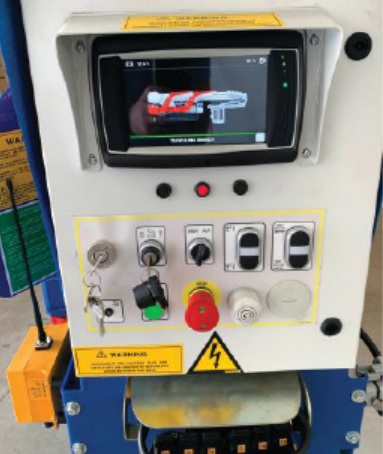 Drawing a picture
Drawing a picture
“I think the biggest difference I’ve seen and experienced with our Palazzani lineup of lifts is the unique touchscreen technology we offer on the TSJ, XTJ, and TZ series,” says Ben Lee Taft, president of Spimerica Access Solutions, a second-year TCIA corporate member company based in Hollywood, Florida. “This screen gives an overview of the machine’s sensors, positions of travel, and diagnostic menu.”
He adds, “If there was a problem or the machine is in a position that is unsafe, the screen will direct the operator on what is needed to correct the setup. This feature will make the operator more comfortable with our machines and also gives more confidence to the operators/owners, knowing our machine will direct them to the solution.
“Service is a vital piece of keeping your lift up and running, and annual inspections are vital for identifying any damages or repairs that need to be made,” Taft says. These lifts, he concludes, are “still very new to the North American market, and we continuously train new and existing customers on proper operation, service and safety factors.”
Final words
“Know your equipment, what it was designed to do, and, equally important, what it was not designed to do,” says Ebbe Christensen, president, and CEO of Ruthmann ReachMaster North America L.P., an 18-year TCIA corporate member company based in Porter, Texas. “More than 50% of serious repairs we see as manufacturers are related to misuse of the equipment, most knowingly and some unknowingly.”
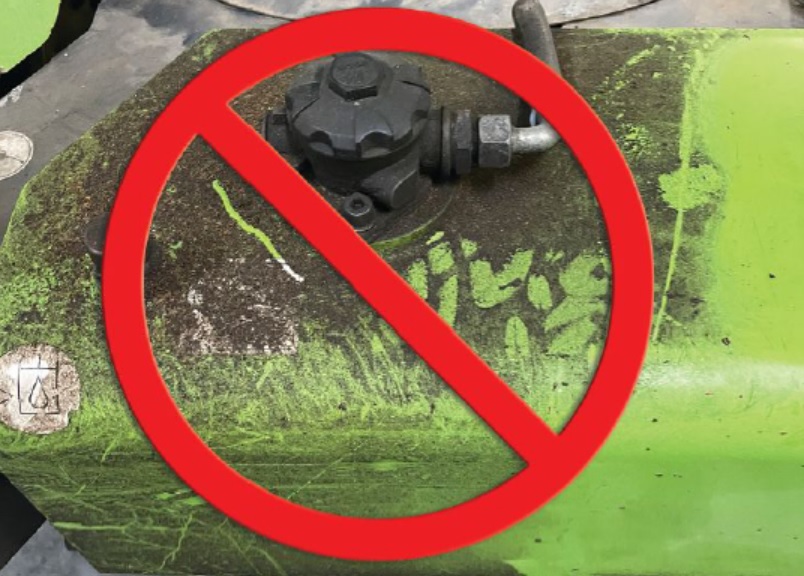
For example, he says, “One of the main culprits is overloading the basket, which can not only be very dangerous but also inflict permanent damage to a lot of components, from basket-leveling systems to hydraulics, pins and structural components. Everything on the unit, from the tracks and up to the basket, is designed to operate with the manufacturer’s listed maximum weight. And, no, the listed weight capacity on the basket is not just a suggested load, it is the maximum load, and should always be religiously observed.
“Another area that often causes serious damage is the daily routine of tying a lift down to a trailer or truck,” he adds. “Most, if not all, manufacturers provide specific strapping and lifting points on the lift, which may not always be in the most practical and/or easy location, but nevertheless the locations that best can handle the tie-down pressures from straps. When other areas that may represent easier or quicker access are used, you can seriously damage, for example, the undercarriage of the unit. Or even worse, if chains are used with a ratchet device, the amount of torque on the chains can cause very serious damage to the unit.”
Annual inspections are not always enough. With cars, it is not just the time factor, but the mileage. When recommending vital inspection intervals, most manufacturers will list a sequence of either time or work hours – whatever comes first – as the critical point when the lift needs to be inspected. Often, the manufacturers also will include detailed information on what needs to be inspected as a minimum and what is recommended. In the tree care industry, the lifts work many hours; still, it often comes as a surprise to owners that most lifts should actually be inspected two to three times a year based on hour use, and not just given the annual inspection.
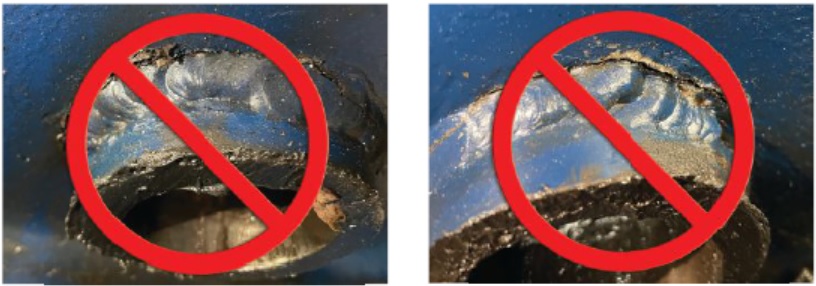
Christensen stresses, “Use qualified, external service providers who make a living out of maintaining lift equipment.”
“Error messages in the electronics (when applicable) are there for a purpose, don’t ignore them. It can be a simple thing, a connector or a sensor, but also can be something much more serious that can lead to other items failing,” Christensen warns.
“Make it a habit to keep records on frequently replaced components, and keep a small inventory of these parts such as outrigger covers, fuses, light bulbs and light (cover) glass, outrigger pads, and other items that typically can be replaced by the owner. Also, establish a good relationship with a local repair shop before you need it, so you know whom to call.”
He concludes, “Preparing for maintenance and keeping downtime to a minimum is a combination of several activities that, each in their own way, are incredibly logical and simple, yet they are often overlooked during daily operation. The sum of them, however, provides you with the best possible position to be in control of the maintenance of your equipment while being prepared for the day any unexpected repair is needed.”
As you sift through these observations, it should be pretty obvious that most “fails” are avoidable, and that the blame for most of what goes on is pretty much human error. So – no excuses!

